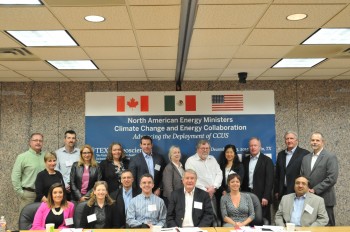Top Energy Officials from North America Gather at The University of Texas at Austin to Collaborate on Carbon Capture Solutions
December 4, 2015

Energy officials from across North America met at The University of Texas at Austin Bureau of Economic Geology Dec. 2 and 3 to discuss how the United States, Canada and Mexico can collaborate to advance carbon capture and storage, a key technology to fight climate change and produce cleaner energy.
“We’re really proud to host such a committed and dynamic group of countries interested in climate change mitigation through CCUS (carbon capture, utilization and storage),” said Susan Hovorka, a senior research scientist and principal investigator at the bureau’s Gulf Coast Carbon Center.
The emerging technology of carbon capture, use and storage is thought to be a key strategy for reducing carbon emissions produced by burning fossil fuels. Capturing and storing carbon dioxide typically entails pumping it underground or deep under the seafloor into geological formations that can hold the greenhouse gas so it is not released into the atmosphere. Carbon dioxide can also be used to enhance oil production from fields with declining production, a method called enhanced oil recovery (EOR). Coincidentally, much of the carbon dioxide used in EOR is permanently trapped in the oil-bearing formation. .
Nineteen officials representing government, industry, policy and academic institutions attended the event to discuss their own experience in CCUS development and to plan best practices for collaboration between their countries and organizations. Representatives from the U.S. and Canada attended the event at the Bureau of Economic Geology, a unit of the University of Texas Jackson School of Geosciences, while Mexican officials participated remotely.
“Meeting the last day and a half was to generate other ideas, and I think we’ve been very successful in that,” said Robert Wright, a senior advisor at the U.S Department of Energy.
“It’s been a very good meeting due to the participants coming with their ideas and being willing to discuss them in an open manner.”
After the meeting, the group selected public outreach and developing mechanisms for research collaboration between countries and companies as the top issues that they should focus future efforts on.
“We just picked what we think are the top two [ideas]…and like many things we have to go back and put some thought into how we frame up the question and get buy-in from everyone,” Wright said.
The group is planning to continue their discussions in April 2016 at a meeting in Mexico City.
The meeting was part of the North American Energy Ministers’ Working Group on Climate Change and Energy created last year by Mexican Secretary of Energy Pedro Joaquin Coldwell, U.S. Secretary of Energy Ernest J. Moniz and then Canadian Minister of Natural Resources Greg Rickford (since replaced by James Carr).
The University of Texas at Austin is an international leader in developing carbon capture and storage technology. Last year it received a $12 million research grant for the technology and hosted the world’s leading conference on carbon capture and storage research.
